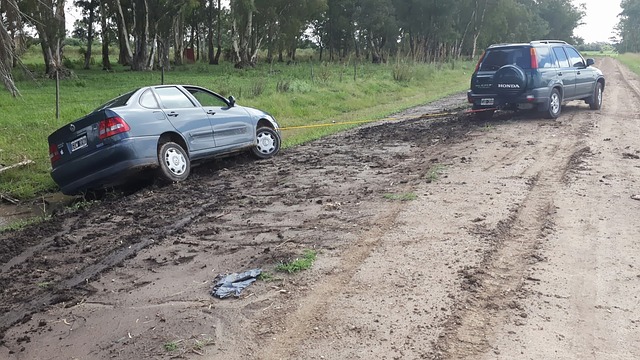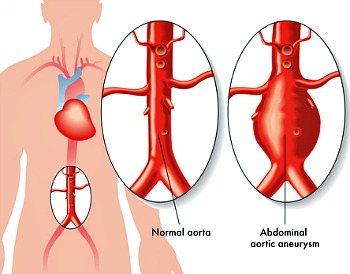Abdominal Aortic Aneurysm
Risk Factors, Diagnosis, And Treatment Options

Albert
Einstein was a theoretical physicist and a genius by most people’s standards. A
Nobel Prize winner and recipient of the Franklin Institute Medal, Einstein remains
a cultural icon who personified 20th century innovation. On April
18, 1955, Albert Einstein died of an abdominal aortic aneurysm, a condition
wherein localized ballooning of a segment of the aorta ruptures and causes
internal bleeding.
What is an Abdominal Aortic Aneurysm?
An abdominal aortic aneurysm is the enlargement, swelling, or widening of the aorta, the main blood vessel that runs from the heart through the abdomen and into the legs. The aorta is the largest blood vessel in the body. It starts off from the left part of the heart, curves downward and backward to continue down into the chest (thorax).
In the chest, it is known as the thoracic aorta. A ballooning or aneurysm can occur here. If it does, it is called thoracic aortic aneurysm. The aorta continues its downward course, passes through a natural opening in the diaphragm at the level of the tenth thoracic vertebra (spine bone) and becomes the abdominal aorta.
The most common site of ballooning of the aorta is in the abdomen, just below the kidneys. The aorta gives off several major branches as it passes from the chest through the abdomen before it divides into iliac vessels and goes into the legs. Two such branches are the arteries to the right and left kidneys called the renal arteries.
Abdominal aortic aneurysms commonly affect men over the age of 65, with only two-thirds of diagnosed cases of abdominal aortic aneurysm being men.
Between 2005 and 2012, more than 29.000 patients underwent surgery to repair intact abdominal aortic aneurysms. Catching an abdominal aortic aneurysm before it ruptures is crucial, as 80% of patients with ruptured aneurysms die (many of them on the way to the hospital). Surgery survival rate for ruptured abdominal aortic aneurysms is 50%. Reports estimate that 34 in every 100.000 people die of AAA per year in the UK.
Types of AAA
An abdominal aortic aneurysm can be classified into a number of different categories based on:
- Size of the ballooning segment
- Shape
- Number of layers of the aorta affected
- Level at which the abnormal widening or ballooning of the artery occurs
Diameter Or Size Of The Aneurysm
Size is the most important way of classifying an abdominal aortic aneurysm. Treatment options for aneurism of the abdominal aorta are based mainly on the size. There are three types of AAA described using size classification. They include:
- Small aneurysms measure between 3cm and 4.5cm
- Intermediate aneurysms measure between 4.6cm and 5.4cm
- Large aneurysm measure 5.5cm or more
Shape
There are two forms of aneurysm of the abdominal aorta based on shape. They are
It is useful to know
the shape of an abdominal aortic aneurysm because treatment with antifungal
medications may be needed if it is thought to be important in the aetiology of
the disease.
Number Of Layers Of The Aorta Affected
Depending on the number of the walls of the aorta involved, aortic aneurysms can be described as true or false aneurysm.
A true aneurysm has all three layers of the wall of the aorta involved in the ballooning. It is a true dilatation of the aorta. This is further divided into fusiform abdominal aortic aneurism, or saccular abdominal aortic aneurysm. The fusiform type of abdominal aortic aneurism is more common, and may extend beyond 20cm to involve the iliac arteries.
A false abdominal aortic aneurysm is one where not all three layers of the wall of the aorta are involved
in the ballooning. This usually occurs due to penetrating injury or infection.
Level At Which The Abnormal Widening Or Ballooning Of The Artery Occurs
Infra Renal Aortic Aneurysm
Nine out of ten cases (90%) of abdominal aortic aneurysm occurs below the point or level in the aorta where the renal (kidney) arteries have come off it. This is called infra renal abdominal aortic aneurysm. It is the safer variety since the kidneys may not be badly affected before or after the surgery.
Supra Renal Aortic Aneurysm
If the ballooning of the aorta occurs before the aorta gives off the renal branches, it is called supra renal abdominal aortic aneurysm. This condition can deliver serious consequences for the kidneys, as the ballooning above the level of the kidneys may mean less blood flow pressure to the kidneys. The repair also has increased risk. Supra renal aortic aneurysm happens in one out of ten cases of abdominal aortic aneurysm.
Aneurysm of the
abdominal aorta could extend to involve one or both terminal branches (iliac
arteries).
Cause of Abdominal Aortic Aneurysm
The exact cause of abdominal aortic aneurysm (AAA) is not known. However, the following factors are known to contribute to the formation of an abdominal aneurysm:
- Degeneration of the wall of the aorta due to chronic fat deposit (atherosclerosis). This is believed to be the cause of abdominal aortic aneurysm in 90% of cases. Degeneration leads to loss of the natural elasticity of the wall of the aorta, preventing the aorta from expanding and recoiling as it should. The wall starts to stretch and crack. Over time, the wall thins out and may start to leak or even rupture without warning.
- Another cause of aortic aneurysm is genetic defects in the structure of the proteins called collagen and elastin. These proteins are the building blocks of the wall of the aorta. Deficient elastin causes the aorta to dilate and defective collagen encourages rupture. A disease affecting both these proteins compromises the strength of the blood vessels. This happens with connective tissue disorders such as Ehlers-Danlos syndrome and Marfan syndrome.
- Injuries to the aorta either from direct force like a seat belt injury from a car crash, or from infections like syphilis, fungi, or mycotic infections (which causes very high rates of rupture) can cause abdominal aortic aneurysm.
- Inflammatory diseases of the arteries called arteritis can cause aneurysms.
- Subacute bacterial endocarditis can cause aneurysms.
- Cystic medial necrosis (death of the wall of the aorta) can cause aneurysms.
 The impact of an auto accident can cause an abdominal aortic aneurysm
The impact of an auto accident can cause an abdominal aortic aneurysmIn the UK and US, abdominal aneurysm is believed to be present in 3 out of every 100 individuals after the age of 50. About 6 men are affected for every woman found with this disorder, and four times more common in whites than blacks. Occurrences of the disease is also more common after the age of 50, with a peak incidence around 70 years of age.
Other risk factors for abdominal aortic aneurysm include:
- Presence of high blood pressure
- High cholesterol
- Hardened arteries
- Smoking
- Family history of AAA
Symptoms of AAA
An abdominal aortic aneurysm often does not cause any symptoms at its onset. The rate of swelling or dilation of the aorta is typically gradual, increasing only a few millimeters per year, so it is possible for a patient’s condition to worsen over years without ever knowing. It is not until the dilation becomes large enough (3 to 5cm) that medical attention becomes necessary.
Aortic aneurysms are often found during routine examinations, scans, or X-rays for other medical conditions.
Common symptoms of an abdominal aortic aneurysm include:
These symptoms or combination of them could vary greatly from one person to another. If you suspect you might be having abdominal aortic aneurysm, contact your doctor immediately. The chance of surviving a ruptured abdominal aortic aneurysm outside the hospital is only 10 to 20%.
Treatment
Options for an Abdominal Aortic Aneurysm
The exact size or point at which an operation becomes absolutely necessary for an aneurysm of the aorta is not known with certainty. However, it is generally agreed that a surgical repair of an aneurysm should take place if the abdominal aortic aneurism is more than 4.0cm.
Results from screen programs suggest that at 5.5cm (which is more than double the size of a normal aorta), everyone with this condition should have the aneurysm repaired. If at 3.5cm though, there is lower abdominal pain, or any symptoms with the aneurysm, then repair is warranted.
A planned repair of an aneurysm provides the patient with the best chance of survival. The survival rate for a planned surgical repair of an intact aortic aneurysm is about 98%. This is in sharp contrast to an emergency repair, following a burst, where the chances of having a successful operation are 50% and less.
There are two main treatment options for repair of an abdominal aneurysm:
It is generally agreed that the endovascular
repair is safer, and more appropriate for a planned surgery, especially if the
aneurysm is below the kidney level, and it is not already ruptured.
Abdominal Aortic Aneurysm: Share Your Story
Do you or a close relative suffer with AAA? How was this diagnosed, and what size is it at the moment? Did you suffer with any symptoms? How was it treated - surgery, watchful waiting or EVAR (minimally invasive surgery)? Any complications?
Share your story here and help spread the vital message to let others know that this condition is not as uncommon as many would think.
What Other Visitors Have Said
Click below to see contributions from other visitors to this page...
Diane's funny tummy Not rated yet
A stent put in left hand side of heart from abdomen - longest artery in November 2010. Not feeling well since then in upper stomach area. Feeling of "fullness" …
abdominal-ortic-aneurysm comments Not rated yet
I was involved in a motoring accident in December 2006, I noticed that night extensive back and yellow bruising below my ribs , just at the point where …
|
Help Keep This Site Going |

You can read more about aneurysm of the abdominal aorta and related topics on the following pages:
|
|



